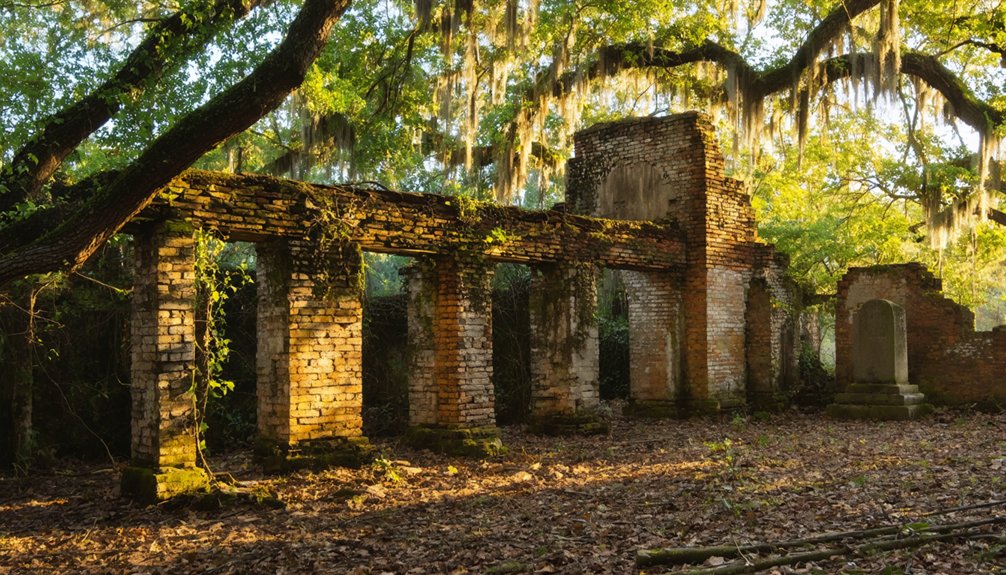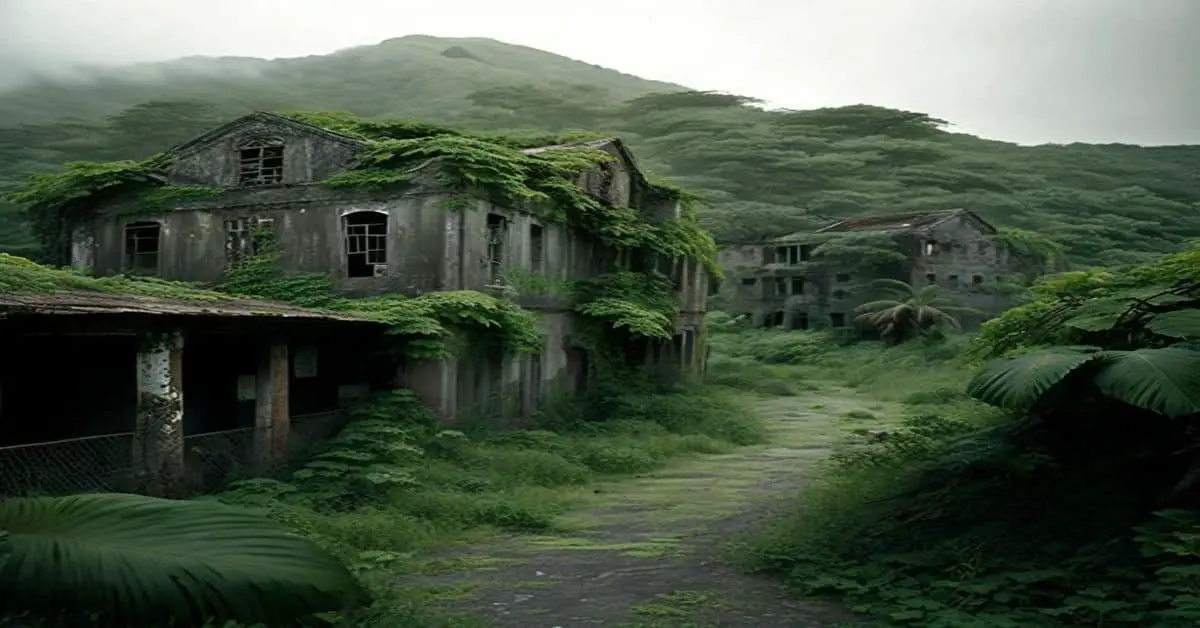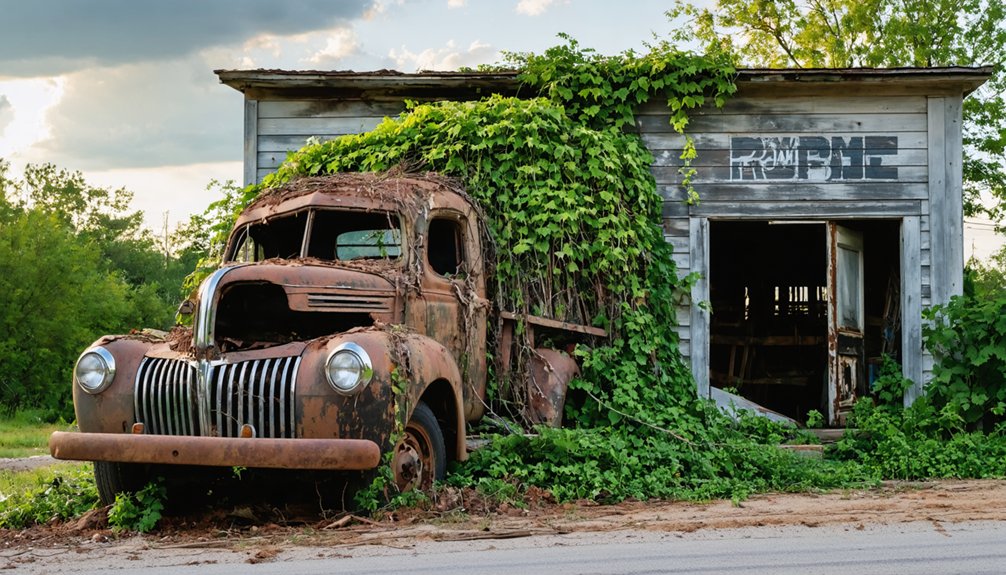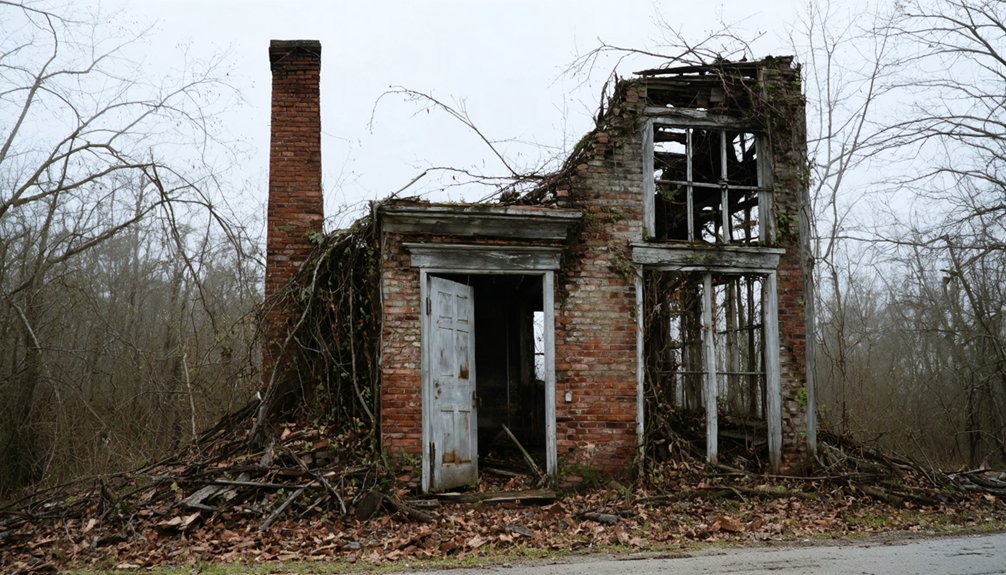You’ll find Blakeley, Alabama’s remarkable ghost town nestled in the Mobile-Tensaw Delta. Founded in 1813, it quickly grew into a bustling port city rivaling Mobile, with over 4,000 residents. Devastating yellow fever epidemics in the 1820s decimated the population, transforming this once-thriving community into abandoned ruins. Today, you can explore its preserved Civil War battlefields, archaeological sites, and historic structures at Historic Blakeley State Park, where centuries of fascinating stories await discovery.
Key Takeaways
- Blakeley, Alabama transformed from a thriving port town of 4,000 residents to a ghost town due to devastating yellow fever epidemics.
- Founded in 1813, Blakeley initially rivaled Mobile with its deep natural harbor and designation as an official U.S. port of entry.
- Yellow fever outbreaks in 1822, 1826, and 1828 led to mass graves and widespread abandonment of the settlement.
- The town’s final major historical event was the Battle of Fort Blakeley in 1865, one of the Civil War’s last battles.
- Now preserved as Historic Blakeley State Park, the ghost town’s ruins and Civil War earthworks span 2,100 acres.
The Rise of a Promising Port Town (1813-1820)
When Josiah Blakeley purchased several thousand acres in the Mobile-Tensaw Delta region, he set in motion the creation of what would become one of Alabama’s most promising early settlements.
The town planning began in 1813 when Blakeley hired a surveyor to plot the land, and the first ten lots sold quickly for $1,000. Economic factors favored the new settlement’s success, particularly its deep natural harbor that could accommodate ships too large for Mobile’s port. In 1822, Blakeley achieved another milestone when it was designated as an official port of entry for the United States.
After its incorporation in 1814 by the Mississippi Territorial Legislature, you’d have witnessed Blakeley’s rapid transformation into a bustling port town. The strategic location attracted investors from Mobile and northern states, while the end of the Creek War opened up unprecedented opportunities for river and bay trade. The thriving maritime economy supported a growing boat-building industry, which produced notable vessels like the Mississippi and Tensas steamers.
Yellow Fever’s Devastating Impact
The thriving port town of Blakeley faced an unexpected enemy in the 1820s that would forever alter its destiny. Yellow fever struck with devastating force in 1822, 1826, and 1828, transforming a bustling community of 4,000 residents into a ghost of its former self.
Three deadly waves of yellow fever transformed Blakeley from a thriving port of 4,000 into a desolate ghost town.
You’d have witnessed mass graves being dug as the deadly disease claimed countless lives, leaving few survivors in its wake. The town’s historic cemetery serves as a solemn reminder of those lost during the epidemics.
At the time, you wouldn’t have known mosquitoes were spreading the disease. Instead, locals blamed “bad air” from surrounding wetlands, attempting futile prevention methods like burning tar and spreading quicklime. The Aedes aegypti mosquito thrived in the urban environment of Blakeley, making the town particularly vulnerable to outbreaks.
This devastating series of epidemics triggered an unstoppable population decline, and by the Civil War era, barely a hundred residents remained in what was once a town larger than Mobile.
Strategic Civil War Battleground
If you visit Blakeley today, you’ll find yourself at the site of one of the Civil War’s final major battles, where Union forces overwhelmed Confederate defenses on April 9, 1865 – the same day as Lee’s surrender at Appomattox.
The battle involved complex fortifications including a three-mile line of earthworks, nine redoubts, and various defensive obstacles like primitive land mines and sharpened tree barriers.
The Union assault was carried out by sixteen thousand troops under Major General Canby, vastly outnumbering the Confederate defenders.
You can still examine many of these preserved military structures, which protected Mobile Bay’s eastern approach and formed an essential part of the Confederacy’s last major port defenses. The intense battle lasted just thirty minutes before the Confederate garrison was captured.
Final Major Battle Site
During the final months of the Civil War in 1865, Fort Blakeley emerged as the site of one of the conflict’s last major battles, pitting Union Major General Edward R. S. Canby’s 16,000 troops against Confederate Brigadier General Liddell‘s 4,000 defenders. The battle was noteworthy as it occurred on the same day as Lee’s surrender at Appomattox.
Today, this ghost town’s battlefield bears witness to the dramatic final battle that secured Mobile’s fate just hours after Lee’s surrender at Appomattox. The site is now preserved as Historic Blakeley State Park.
- You’ll find remains of three miles of earthwork fortifications, including nine redoubts and defensive obstacles like primitive land mines.
- The assault saw 5,000 African-American troops play a vital role in breaching Confederate defenses within 30 minutes.
- Union forces captured over 2,800 Confederate prisoners while suffering roughly 800 casualties.
- The victory effectively secured one of the Confederacy’s last major ports, with Mobile falling on April 12.
Preserved Military Fortifications
Spanning approximately 3,800 acres across the Mobile-Tensaw Delta, Fort Blakeley’s preserved military fortifications stand as some of the most impressive Civil War earthworks in the American South.
You’ll find a sophisticated network of military architecture stretching for three miles, including nine major redoubts, strategic artillery batteries, and interconnected rifle pits. The historical significance of these defenses is evident in their innovative design, featuring abatis made from felled trees and primitive land mines. The site culminates at Redoubt #4, where Union forces launched their decisive assault that broke through Southern lines. Under the command of Maj. Gen. Frederick Steele, approximately 16,000 Union troops converged on the fort for the final assault.
Confederate engineers maximized the natural terrain, incorporating nearby swamps and flooding patterns into their defensive strategy.
The fortifications showcase overlapping fields of fire, approach trenches, and carefully positioned breastworks that protected roughly 2,500 soldiers and 40 artillery pieces guarding crucial supply routes to Mobile Bay.
Life in Early Blakeley Society
While Blakeley’s urban development proceeded at a breakneck pace between 1813 and 1822, its social fabric wove together a diverse tapestry of inhabitants. You’d find Christian Apalachee natives living alongside French settlers and American entrepreneurs, creating a vibrant mix of cultures in this bustling port town.
Community gatherings centered around churches, markets, and the busy ferry terminal that connected Blakeley to Mobile.
- You could attend town meetings where a literate citizenry debated local affairs, as evidenced by the town’s newspaper.
- You’d witness ships being built at local yards like Brown and Bell.
- You’d find yourself among 4,000 residents at the town’s peak – nearly double Mobile’s population.
- You could participate in a thriving marketplace where merchants and sailors converged at Alabama’s official port of entry.
Natural Resources and Environmental Challenges
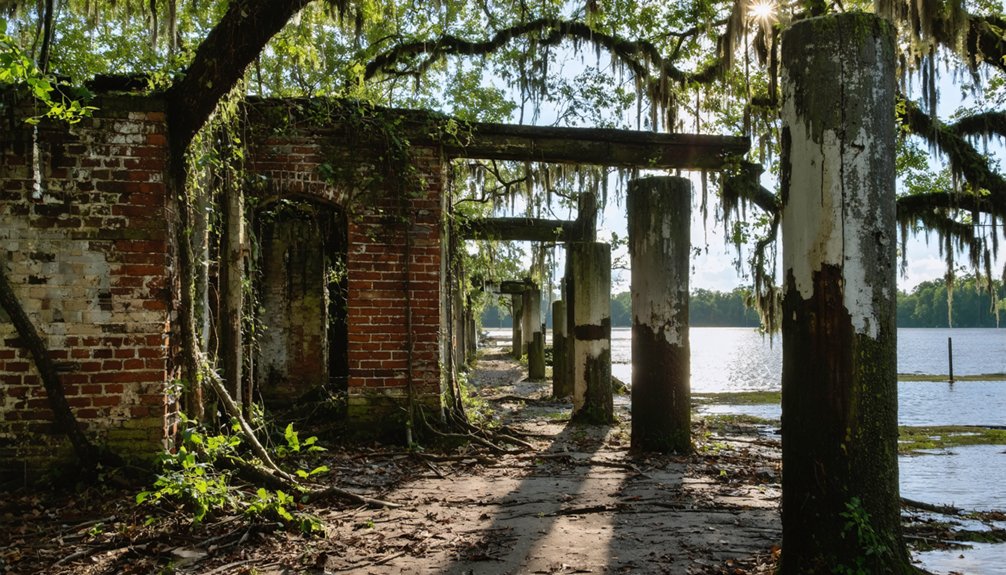
You’ll find Blakeley’s rich delta wetlands ecosystem played a dual role in the town’s development, providing abundant natural resources while harboring challenges.
The extensive network of waterways and marshes created ideal breeding conditions for disease-carrying mosquitoes, which greatly impacted early residents’ health and daily life.
These wetland conditions ultimately contributed to Blakeley’s decline, as mosquito-borne illnesses like yellow fever and malaria repeatedly swept through the population.
Delta Wetlands Ecosystem
The Mobile-Tensaw Delta’s wetlands ecosystem forms a vibrant tapestry of life spanning 260,000 acres in southwestern Alabama.
You’ll discover an incredible wetland biodiversity featuring over 500 plant species and hundreds of wildlife species in this region often called “America’s Amazon.”
The delta’s ecosystem conservation efforts protect 185,500 acres through federal and state partnerships, safeguarding essential habitats and natural resources.
- Experience bottomland hardwoods, marshes, and swamps teeming with 300 bird species
- Explore waters supporting 126 fish species perfect for recreational and commercial fishing
- Witness the delta’s significant role in filtering the nation’s freshwater supply
- Navigate through diverse wetland systems influenced by seasonal flooding patterns
Disease-Carrying Mosquito Impact
Disease-carrying mosquitoes played a devastating role in Blakeley’s decline, particularly through yellow fever epidemics that struck in 1822, 1826, and 1828. The town’s riverside location and surrounding wetlands created perfect breeding conditions for mosquitoes, though residents didn’t yet understand the connection between the insects and the disease’s transmission.
You’ll find that these outbreaks led to mass graves and a dramatic population decrease, earning Blakeley a reputation as an unhealthy settlement.
It wasn’t until 1900 that public health officials confirmed mosquitoes as the disease vector, but by then, Blakeley had already suffered irreparable damage.
The Alabama Department of Public Health, established in 1875, later implemented quarantine measures and mosquito control programs, but these advances came too late to save the once-thriving riverfront town.
Archaeological Discoveries and Native Heritage
Archaeological exploration of Blakeley reveals a rich tapestry of Native American heritage and colonial settlement within Alabama’s Mobile-Tensaw Delta region.
You’ll find evidence of mound-building cultures and early European settlements preserved in the wetland environment, where archaeological findings continue to uncover the complex interactions between Native Americans and settlers.
- Native artifacts and military equipment from the Civil War era provide insights into daily life and historical events.
- The wetland environment has uniquely preserved organic materials that would typically deteriorate in other locations.
- Archaeological evidence suggests extensive trade networks between Native American tribes and European settlers.
- The Battle of Fort Blakeley site offers potential discoveries of military artifacts from 1865.
You can explore these remnants of the past while traversing preservation challenges posed by erosion and decay in the delta’s dynamic ecosystem.
Preserving History at Historic Blakeley State Park
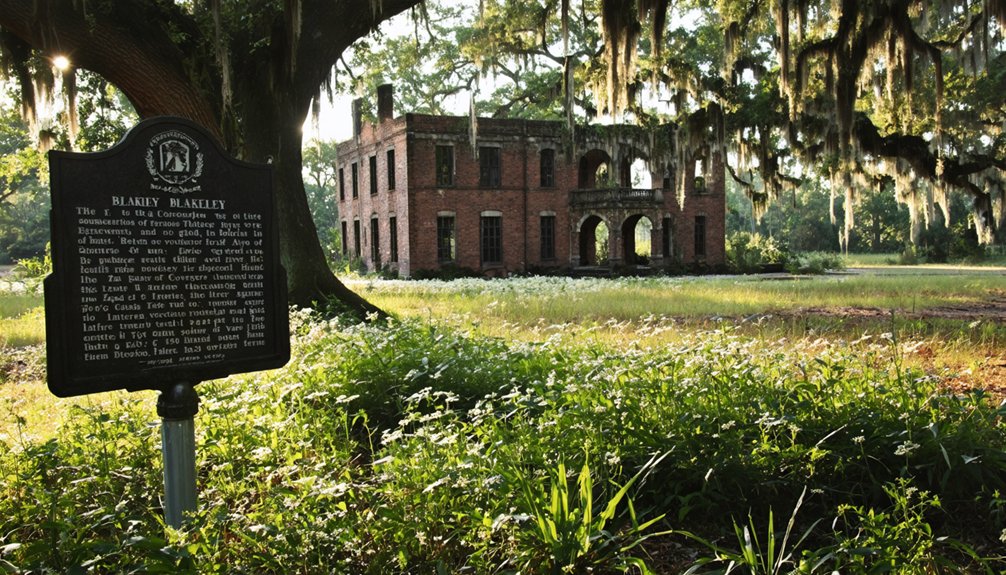
Building on the archaeological legacy, modern preservation efforts at Historic Blakeley State Park have transformed this once-bustling town into Alabama’s largest National Register Historic Site.
Modern preservation has breathed new life into Historic Blakeley State Park, making it a testament to Alabama’s rich archaeological heritage.
You’ll find 2,100 acres of carefully preserved history, including miles of Civil War earthworks and the remnants of what was once Alabama’s largest city in the 1820s.
The Historic Blakeley Authority, established in 1981, maintains this independent state park’s historic preservation mission through community engagement programs.
You can explore over 20 miles of trails, attend educational lectures, or join guided tours that bring the site’s rich history to life.
The Gatra Wehle Center hosts special events, while boat cruises into the Mobile-Tensaw Delta combine natural and historical interpretation, ensuring you’ll experience both the cultural and ecological significance of this remarkable site.
Frequently Asked Questions
What Happened to Blakeley’s Original Buildings and Construction Materials?
You’ll find most building materials were dismantled and moved to Mobile for reuse as the ghost town declined. People gradually took what they could salvage, while nature reclaimed what remained.
Were There Any Documented Supernatural Occurrences in Abandoned Blakeley?
You’ll find documented ghost sightings near Blakeley’s cemetery, fortifications, and “hanging tree.” Modern paranormal investigations regularly record unexplained phenomena, including apparitions of Confederate soldiers and mysterious voices during evening tours.
How Did Residents Cope With Daily Life Between Major Yellow Fever Outbreaks?
You’d maintain your daily routines through community support, continuing trade at the port, attending social events, reading the weekly newspaper, and avoiding swampy areas while staying vigilant for signs of disease.
What Specific Businesses and Industries Operated in Blakeley During Its Peak?
You’d find cotton plantations, shipbuilding industries, lumber mills, warehouses, general stores, public houses, and commodity brokers thriving at Blakeley’s peak, with steamboat construction driving much of the port’s commerce.
Did Any Families Maintain Continuous Residence in Blakeley After Its Abandonment?
You won’t find any family history of continuous residence after Blakeley’s decline. The harsh yellow fever epidemics and mass exodus by the 1840s left the town completely devoid of permanent inhabitants.
References
- https://en.wikipedia.org/wiki/Blakeley
- https://www.exploresouthernhistory.com/blakeley2.html
- https://encyclopediaofalabama.org/article/blakeley/
- https://midwestwanderer.com/article/historic-blakeley-state-park-ghost-town-and-battlefield/
- https://www.blakeleypark.com/About/About-Us
- https://www.youtube.com/watch?v=RS4SfNI13tk
- https://www.alabamapioneers.com/towns-in-the-alabama-territory-the-ghost-town-of-blakeley-was-destined-to-become-a-great-city/
- https://ayptravels.com/2021-quick-trips-part-12-blakely-a-town-in-memory-only/
- https://blakeleypark.stqry.app/story/156085
- https://www.hmdb.org/m.asp?m=131864
